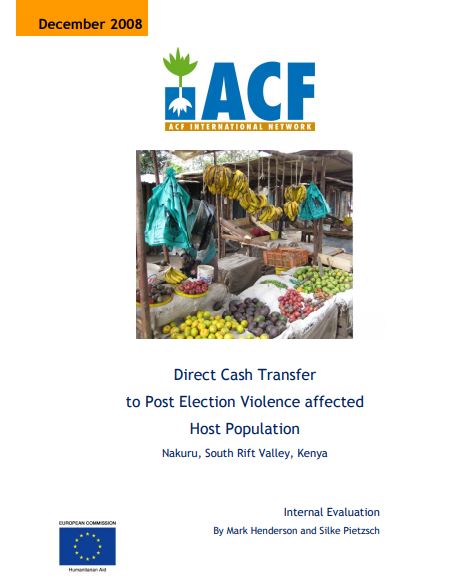Direct Cash Transfer to Post Election Violence affected Host Population: Nakuru, South Rift Valley, Kenya. Internal Evaluation
Post-election violence in Kenya started in late December 2007 and led to a large-scale destruction of property, disruption of transportation and labour markets, and displacement of an estimated 250.000 to 300.000 people throughout the country. Homes and shops were burnt or looted; farms were affected as they did not have available labour to harvest or process crops, or the transportation system to move crops to markets. Families had to abandon their homes to live in police-protected camps or with family and friends. The whole situation resulted in a large scale loss of livelihoods for thousands of people.
Rift Valley Province was one of the hardest hit areas in Kenya, and still hosts just over 100,0002 Internally Displaced Persons (IDPs). In addition to the large population which has been displaced and has been accommodated in organised camps, the local host population has stretched their resources to accommodate those who have been displaced. The overall NGO response was good, and the government has been able to provide compensation to the majority of those who lost their livelihoods and were displaced. However this assistance has only been offered to IDPs who were living in camps. IDPs living in host communities have received minimal assistance from both humanitarian organisations and the Government.
After the detailed assessment of the food security and livelihood (FSL) situation of the displaced and local host communities in Nakuru in March 2008, ACF received funding from ECHO to implement a direct cash transfer programme supporting the local host population.
1000 households were rigorously selected amongst the local population, and received 100 Euros through a direct transfer into a personal bank account. The money was transferred in two instalments; 20% and 80% assuming that the first transfer would cover immediate needs, and the second would allow families to invest in their needs for livelihood recovery. Households also received training and mobilisation on small business management as to reinforce the investment of the cash that was received.
The cash transfer was facilitated in collaboration with Equity Bank, where all benefiting households had or opened an account. The allocated cash was transferred in October and in November. Monitoring was facilitated in the beginning and throughout the programme (Oct and Dec 08) as to ensure good baseline information and follow up datasets. In December 2008, an internal evaluation was conducted and is documented in this report.



